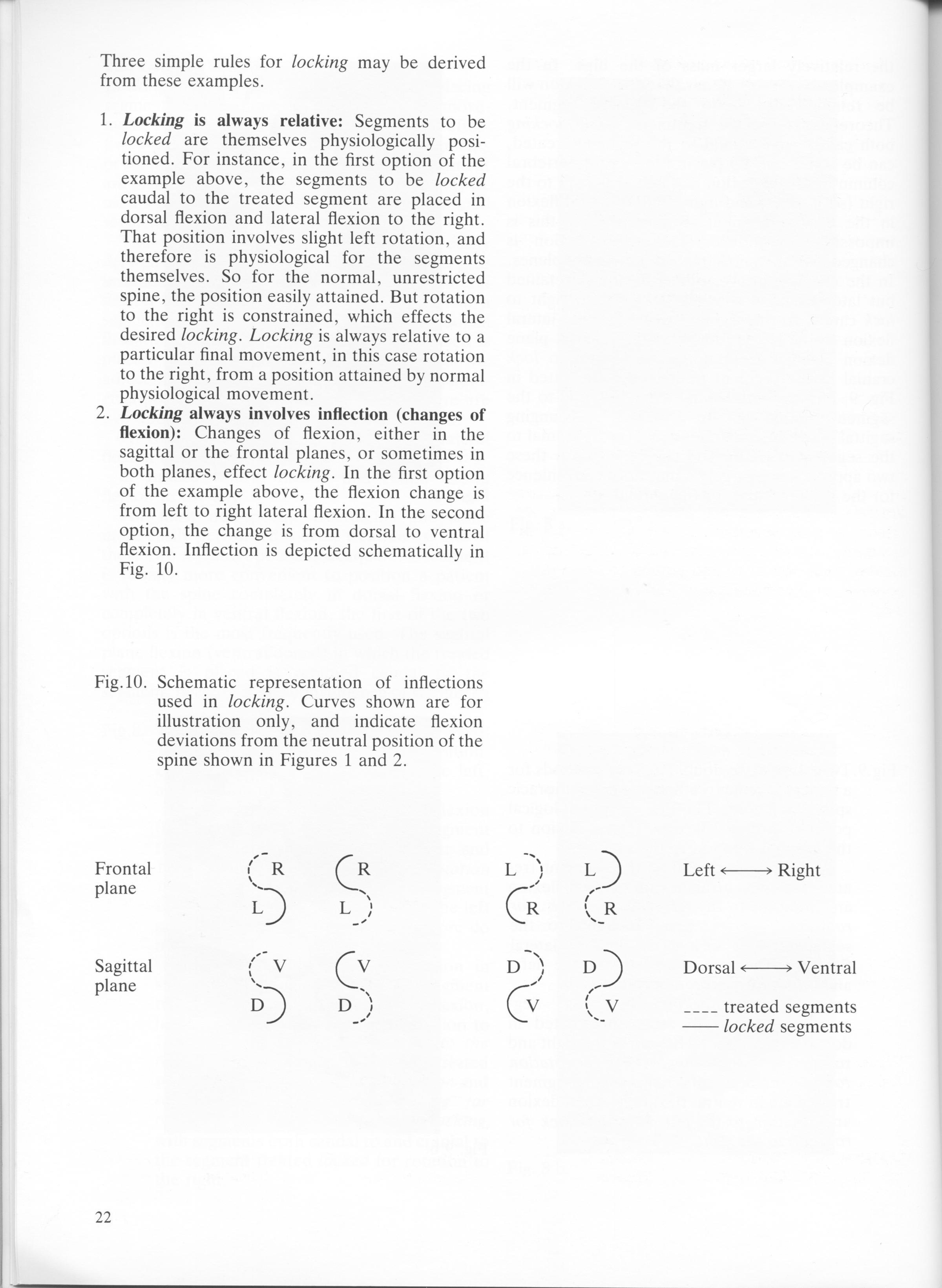22 (936)

Three simple rules for locking may be derived
from these examples.
1. Locking is always relative: Segments to be locked are themselves physiologically posi-tioned. For instance, in the first option of the example above, the segments to be locked caudal to the treated segment are placed in dorsal flexion and lateral flexion to the right. That position involves slight left rotation, and therefore is physiological for the segments themselves. So for the normal, unrestricted spine, the position easily attained. But rotation to the right is constrained, which effects the desired locking. Locking is always relative to a particular finał movement, in this case rotation to the right, from a position attained by normal physiological movement.
2. Locking always involves inflection (changes of flexion): Changes of flexion, either in the sagittal or the frontal planes, or sometimes in both planes, effect locking. In the first option of the example above, the flexion change is from left to right lateral flexion. In the second option, the change is from dorsal to ventral flexion. Inflection is depicted schematically in Fig. 10.
Fig. 10. Schematic representation of inflections used in locking. Curves shown are for illustration only, and indicate flexion deviations from the neutral position of the spine shown in Figures 1 and 2.
|
Frontal |
( R |
( R |
L ') |
O |
Left <-* Right |
|
piane |
V N |
r' |
* t | ||
|
O |
L ) |
C_R |
\ R >»_ | ||
|
Sagittal |
fv |
O |
D ) |
Dorsal «-*■ Ventral | |
|
piane |
\ |
G |
/ | ||
|
D J |
D i |
\ V |
____treated segments | ||
|
_ »» |
-locked segments |
22
Wyszukiwarka
Podobne podstrony:
sc0000 PUONETIC TRANSCRIPTION FOR IiNCLISH MAY BE VERY USEFUL!!!POL1SH <tak, mak, lak, rak, kara,
MySQL distributions for Windows can be downloaded from http://dev. mysq I .com/down loads/. S ee&nbs
Lexical Semantics vs. Historical Semantics Linguistic Structuralism Meaning may be investigated from
OtherStorage Engines Other storage engines may be available from third parties and community members
Command linę arguments • A program may be called from a command linę •
SPECIFICATIONS COLOURS AND CONTENTS MAY BE VARY FROM ILLUSTRATIONS/! WARNING:CHOKING HAZARD Sr*
az (20) Frames and Borders Quilled frames for photographs, smali pictures etc., are very attractive.
img166 (3) 22 22 CN: Use a light blue for D, black for F, and gray for H. (1) Do n
Mm 18 22 26 30 temperaturę ratrngs for iroups (CEG =
skanowanie0035 (12) Criteria levels of performance The reąuired level of performance for success sho
OMiUP t2 Gorski�2 AU rights reserved. No part ofthis puhlication may, for sedes purposes be reproduc
swissbankaccount Swiss Bank Account Holder of this card may cxchange it, at any time, for 25MB&
jff 116 DIGEST OF GENERAL RULES FOR JUDO CONTEST It is commonly reąuired in Judo contest that the pl
mob influence This card may be played at any limę, and counts as the action for the group it affects
newblood This card may be płaycd at any time, and counts as the action for the group it affects. The
więcej podobnych podstron